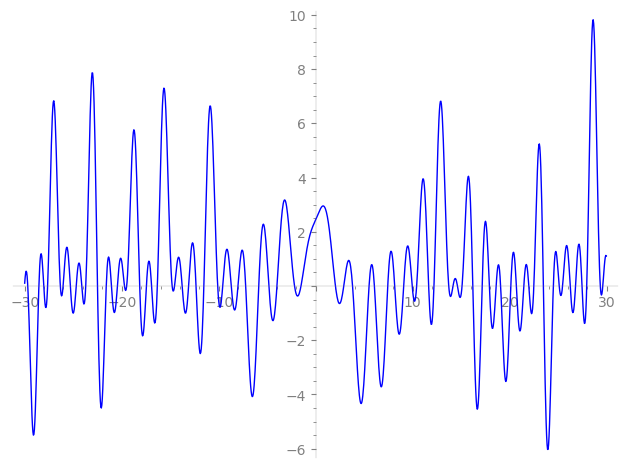| L(s) = 1 | + (1.74 − 0.565i)3-s + (2.00 − 2.75i)5-s + (2.13 − 1.56i)7-s + (0.282 − 0.205i)9-s + (1.95 + 2.67i)11-s + (−3.12 + 2.26i)13-s + (1.92 − 5.92i)15-s + (5.18 + 3.76i)17-s + (−1.35 − 4.18i)19-s + (2.83 − 3.92i)21-s − 8.95·23-s + (−2.03 − 6.27i)25-s + (−2.85 + 3.92i)27-s + (−2.95 − 0.961i)29-s + (−0.176 − 0.242i)31-s + ⋯ |
| L(s) = 1 | + (1.00 − 0.326i)3-s + (0.895 − 1.23i)5-s + (0.807 − 0.590i)7-s + (0.0942 − 0.0684i)9-s + (0.589 + 0.807i)11-s + (−0.865 + 0.629i)13-s + (0.497 − 1.53i)15-s + (1.25 + 0.913i)17-s + (−0.311 − 0.959i)19-s + (0.618 − 0.856i)21-s − 1.86·23-s + (−0.407 − 1.25i)25-s + (−0.548 + 0.755i)27-s + (−0.549 − 0.178i)29-s + (−0.0316 − 0.0436i)31-s + ⋯ |
Λ(s)=(=(616s/2ΓC(s)L(s)(0.646+0.763i)Λ(2−s)
Λ(s)=(=(616s/2ΓC(s+1/2)L(s)(0.646+0.763i)Λ(1−s)
| Degree: |
2 |
| Conductor: |
616
= 23⋅7⋅11
|
| Sign: |
0.646+0.763i
|
| Analytic conductor: |
4.91878 |
| Root analytic conductor: |
2.21783 |
| Motivic weight: |
1 |
| Rational: |
no |
| Arithmetic: |
yes |
| Character: |
χ616(41,⋅)
|
| Primitive: |
yes
|
| Self-dual: |
no
|
| Analytic rank: |
0
|
| Selberg data: |
(2, 616, ( :1/2), 0.646+0.763i)
|
Particular Values
| L(1) |
≈ |
2.22095−1.02992i |
| L(21) |
≈ |
2.22095−1.02992i |
| L(23) |
|
not available |
| L(1) |
|
not available |
L(s)=p∏Fp(p−s)−1 | p | Fp(T) |
|---|
| bad | 2 | 1 |
| 7 | 1+(−2.13+1.56i)T |
| 11 | 1+(−1.95−2.67i)T |
| good | 3 | 1+(−1.74+0.565i)T+(2.42−1.76i)T2 |
| 5 | 1+(−2.00+2.75i)T+(−1.54−4.75i)T2 |
| 13 | 1+(3.12−2.26i)T+(4.01−12.3i)T2 |
| 17 | 1+(−5.18−3.76i)T+(5.25+16.1i)T2 |
| 19 | 1+(1.35+4.18i)T+(−15.3+11.1i)T2 |
| 23 | 1+8.95T+23T2 |
| 29 | 1+(2.95+0.961i)T+(23.4+17.0i)T2 |
| 31 | 1+(0.176+0.242i)T+(−9.57+29.4i)T2 |
| 37 | 1+(−0.331+1.02i)T+(−29.9−21.7i)T2 |
| 41 | 1+(−0.131−0.404i)T+(−33.1+24.0i)T2 |
| 43 | 1−9.11iT−43T2 |
| 47 | 1+(2.54−0.827i)T+(38.0−27.6i)T2 |
| 53 | 1+(−10.0+7.30i)T+(16.3−50.4i)T2 |
| 59 | 1+(3.66+1.18i)T+(47.7+34.6i)T2 |
| 61 | 1+(−8.45−6.14i)T+(18.8+58.0i)T2 |
| 67 | 1+1.32T+67T2 |
| 71 | 1+(12.9+9.37i)T+(21.9+67.5i)T2 |
| 73 | 1+(2.20−6.77i)T+(−59.0−42.9i)T2 |
| 79 | 1+(−4.31−5.94i)T+(−24.4+75.1i)T2 |
| 83 | 1+(0.928+0.674i)T+(25.6+78.9i)T2 |
| 89 | 1+3.58iT−89T2 |
| 97 | 1+(1.20+1.65i)T+(−29.9+92.2i)T2 |
| show more | |
| show less | |
L(s)=p∏ j=1∏2(1−αj,pp−s)−1
Imaginary part of the first few zeros on the critical line
−10.10628694817537808631023462740, −9.588151129042187082760964612581, −8.706613222226726535144721591924, −8.011948849369435795837251861778, −7.22056962723936811426904177886, −5.87416383749755014459238773427, −4.82914366940291664991842104433, −3.99527891931610275652458765780, −2.18345622779691534716984027969, −1.51819912626969854230709132097,
2.03345409597298562631132211936, 2.88916095704423994789125952446, 3.79575808576348509777930088690, 5.49853462174348065292433864992, 6.04732942122309693990985521909, 7.42299266329557992300039935456, 8.140601228039087312642584442179, 9.068118442068037612224528390108, 9.944404554082379375194516988320, 10.40403839362428562366955761120

